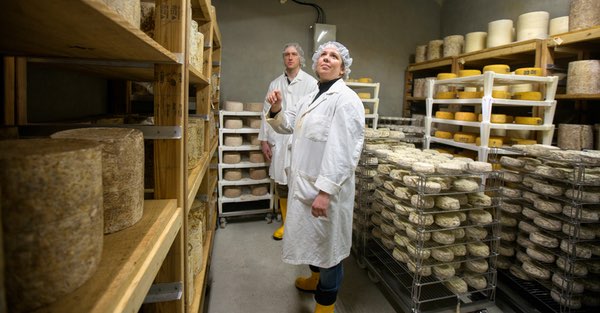- By Cornell University
- Around Town
 Print
Print  Caves master PJ Jenkelunas, rear, and his assistant Krista Jacobsen inspect cheese in the company’s cheese caves in New York City. Photo by Cornell University
Caves master PJ Jenkelunas, rear, and his assistant Krista Jacobsen inspect cheese in the company’s cheese caves in New York City. Photo by Cornell UniversityStep into your local supermarket and chances are the cheese section looks vastly different than it did just a few years ago. Artisan cheesemakers experimenting with intricate flavors and bold styles are reshaping the contours of the cheese market in New York, providing consumers with expanded choices of tastes, textures and aromas.Step into your local supermarket and chances are the cheese section looks vastly different than it did just a few years ago. Artisan cheesemakers experimenting with intricate flavors and bold styles are reshaping the contours of the cheese market in New York, providing consumers with expanded choices of tastes, textures and aromas.
And at the center of it all has been Cornell's College of Agriculture and Life Sciences (CALS). Cheesemakers large and small from across the Northeast have turned to CALS' Food Processing and Development Laboratory (FPDL) for small-batch production and dairy expertise as they develop new recipes.
In 2014, Murray's Cheese in New York City had an idea for a clothbound cheddar modeled on classic British versions. But developing the unique flavor profile posed a challenge for the team from Murray's and their partner, Old Chatham Sheepherding Creamery.
Cornell grad Matt Ranieri, a food science and dairy technology expert, recommended the company take advantage of the resources available in CALS' Department of Food Science. The FPDL, Ranieri knew, allowed for small-batch experimentation to solve tough research and development challenges. At Cornell they tested versions of their prototype cheese in small vats, allowing them to maintain tighter control over its development.
This spring, after two years of development, the company launched Murray's Cavemaster Reserve Ezra – a bright, lemony flavored cheddar named with a nod to Cornell's founder. Created with milk from cows on campus, the cheese is produced at FPDL in Stocking Hall and shipped to Murray's, where it is wrapped in cheesecloth and rubbed with lard before being in placed in rind caves to age for 12 months. It's the newest New York-made clothbound cheddar on the market, and is available online and at their shops in New York City.
Rob Ralyea, senior extension associate and general manager of FPDL, said Cornell's lab offers many advantages for the New York state dairy industry to help companies like Murray's get their products on the market.
"Most commercial vats hold about 30,000 pounds. Here at Cornell we can do small volume runs of 50 gallons, and we can do it by hand, allowing us to understand what's going on throughout the process," Ralyea said. "The investment in research and development is smaller for our clients, and they don't have to lose days of production as they develop a new product."
The flexibility of the space allows cheesemakers to start small as they tweak recipes and scale up production when needed. FPDL also holds workshops on milk, cheese, yogurt, food safety and sanitation, and they are developing their own cheese lines, including an established favorite, Big Red Cheddar.
Artisan cheeses are not only a boon for producers and consumers, but they also help improve farm viability, Ranieri said. Farmers can add value to their existing products by manufacturing higher quality raw material to be used by artisan producers, he said.
Ezra is a prime example.
"All the elements of this cheese hit on a New York theme," said Steve Millard, Murray's senior vice president of merchandising and operations. "We use New York state milk, we get our lard from New York pigs, we age it in New York City, and of course it was developed at Cornell."
v13i29



